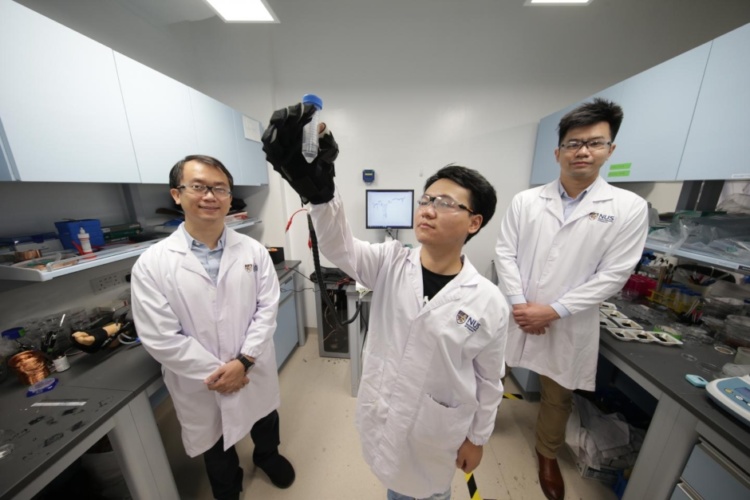
The team is led by assistant professor Chen Po-Yen, from the NUS Department of Chemical and Biomolecular Engineering, who believes that their sensor design principles will ‘significantly enhance’ the performance of soft robots and electronic skins.
Fabricated using flexible, stretchable and electrically conducive nanomaterials called MXenes, the novel sensors are said to be ultra-thin, battery-free and able to transmit data wirelessly. The team’s work was published in the journal ACS Nano in September 2020.
“Performance of conventional strain sensors has always been limited by the nature of sensing materials used, and users have limited options of customising the sensors for specific applications,” explained Po-Yen. “In this work, we have developed a facile strategy to control the surface textures of MXenes, and this enabled us to control the sensing performance of strain sensors for various soft exoskeletons.”
Tech company Realtek Singapore collaborated with the NUS team to develop the sensors. Chairman Dr Yeh Po-Leh said that the company are ‘looking forward to bringing the technologies from the lab to the market’, where researchers hope they could be used in applications such as precision manufacturing, where robotic arms are used to carry out intricate tasks like fabricating microchips.
Textile embedded strain sensor makes it through the wash
Physicists develop 'most sensitive strain sensor ever made'
The team said the sensors could be coated on a robotic arm like an electronic skin to measure subtle movements as they are stretched. When placed along the joints of robotic arms, they could allow the system to understand precisely how much the arms are moving and their current position relative to resting state, a function that currently available strain sensors lack the required accuracy and sensitivity for.
A production process was developed that allowed researchers to create highly customisable ultra-sensitive sensors over a wide working window with high signal-to-noise ratios. A sensor’s working window determines how much it can stretch while maintaining sensing qualities, and a high signal-to-noise ratio allows for greater accuracy as the sensor can differentiate between subtle vibrations and minute movements of the robotic arm.
This allowed the team to customise their sensors to any working window between 0 to 900 per cent, while standard sensors can typically achieve a range of up to 100 per cent. By combining multiple sensors with different working windows, they confirmed they were able to create a single ultra-sensitive sensor that would ‘otherwise be impossible to achieve’.
Next, the research team hopes to improve the sensor’s capabilities and work with the Singapore General Hospital to explore the application in soft exoskeleton robots for rehabilitation and in surgical robots for transoral robotic surgery.
Dr Lim Chwee Ming, senior consultant in Otorhinolaryngology-Head & Neck Surgery at Singapore General Hospital, explained that surgeons rely on sense of touch to feel the area inside of the body when operating. “Cancerous tissues, for instance, feel different from normal, healthy tissue,” Ming commented. “By adding ultra-thin wireless sensing modules to long robotic tools, we can reach and operate in areas where our hands can’t reach and potentially ‘feel’ the tissue stiffness without the need for open surgery.




Poll: Should the UK’s railways be renationalised?
I think that a network inclusive of the vehicles on it would make sense. However it remains to be seen if there is any plan for it to be for the...